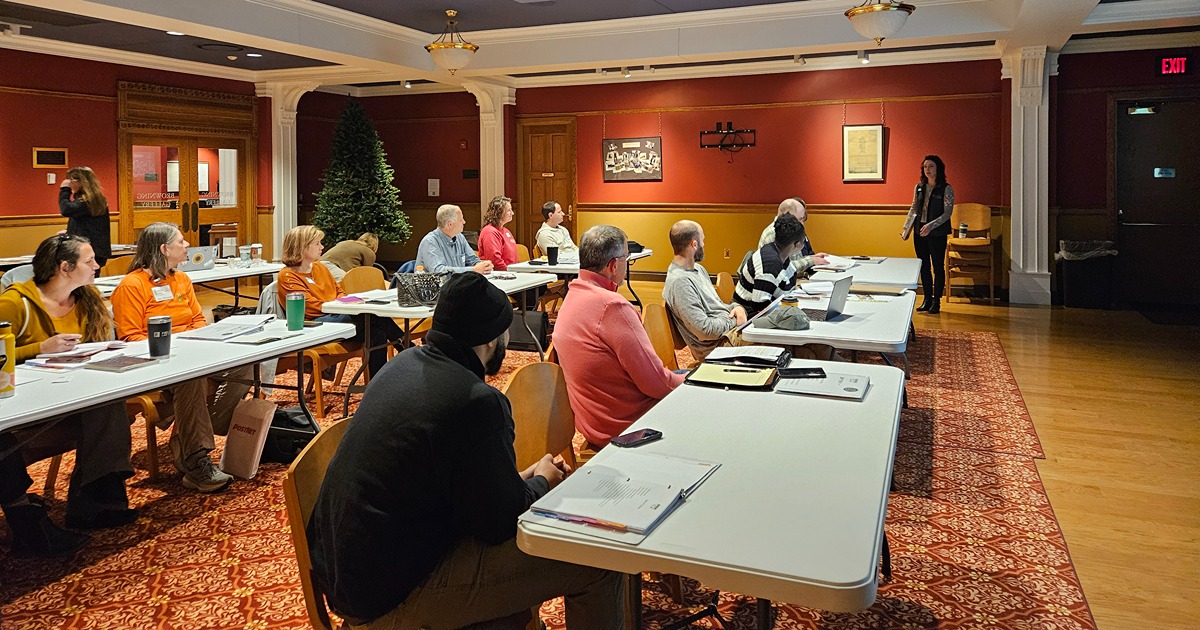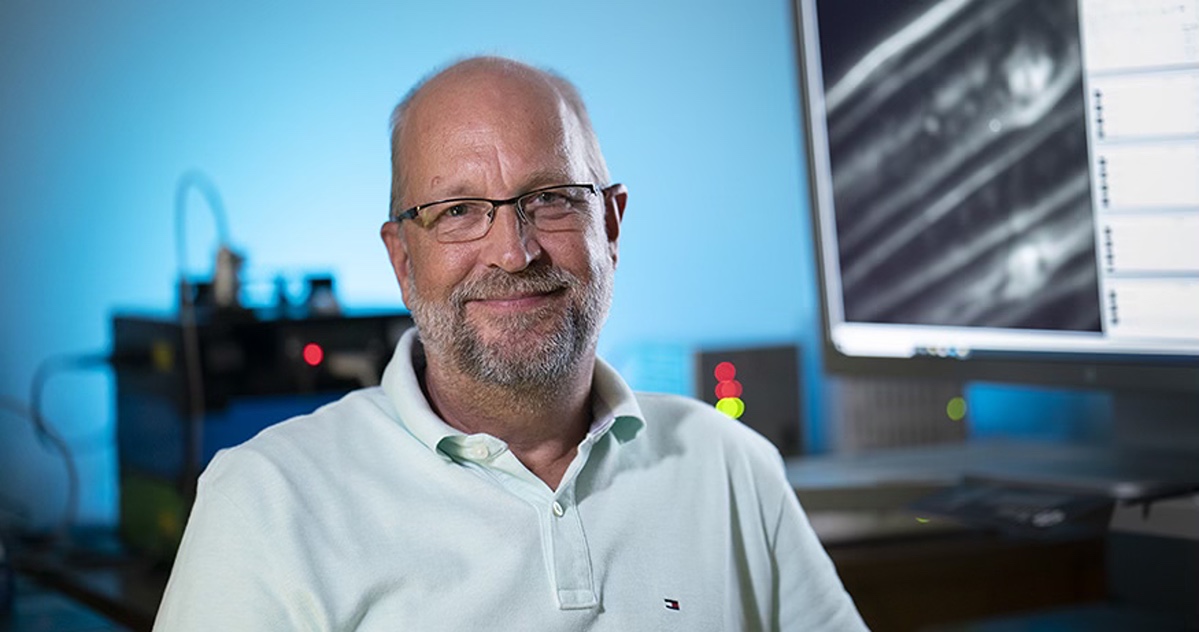New iForester application puts tree knowledge in the public’s pockets
 Katie Grong, a research associate in the Institute for Digital Forestry, uses the iForester app to measure trees on Purdue University’s West Lafayette campus. (Purdue Agricultural Communications photo/Kelsey Getzin)
Katie Grong, a research associate in the Institute for Digital Forestry, uses the iForester app to measure trees on Purdue University’s West Lafayette campus. (Purdue Agricultural Communications photo/Kelsey Getzin) WEST LAFAYETTE, Ind. — Imagine you’re a landowner with dozens or hundreds of mature hardwood trees — not a stretch, since the majority of forestland in the U.S. is privately owned. If you want to know the trees’ value, you’ll need to hire a professional forester.
What if, before you start working with the forester, you could gain preliminary information about the trees’ value and other features with your phone?
That’s the hope behind iForester, an app developed by Purdue University’s Song Zhang, a professor of mechanical engineering, and Cheryl Qian, a professor of industrial design, in collaboration with Songlin Fei, director of the Institute for Digital Forestry.
“This is something that allows the general public to access expert knowledge freely,” Fei said. “I’m very excited about it.”
The idea for the app was born over dinner at a colleague’s house about three years ago, said Fei. He was introduced to Zhang, and the two began to discuss the digital divide in forestry — the way some members of society, especially rural residents, don’t have equal access to new technology.
“But everyone has a phone in their pocket, and everyone knows how to operate a phone, whether you’re 3 years old or 93 years old,” Fei said. “So why don’t we put something on the phone so we can make this digital technology accessible to anyone who’s interested?”
Fei is trained as an ecologist and doesn’t have the specialized expertise to build sensors or apps. But Zhang, a mechanical engineer, had a few ideas.
“We thought, with my background, how can we develop a digital tool so someone can measure a tree by themselves?” Zhang recalled.
Fei and Zhang disclosed their discovery to the Purdue Innovates Office of Technology Commercialization, which ultimately led to the development of the iForester app, now available in the Apple App Store.
Currently the app has one function: measuring a tree’s diameter. It does this using the multiple camera lenses on the back of an iPhone. Developing this type of app presented a unique challenge to Zhang’s graduate students, Wang Xiang and Zhiheng Yin. They needed to figure out a way to filter out foliage and background clutter. Additionally, they needed to identify the standardized height at which tree diameter is measured — about 4.5 feet above the ground — and be able to do all this with high accuracy and security, at a low computational cost, to function on a phone.
The next feature, which the team hopes to have ready soon, will be measuring merchantable and total tree height, which, in conjunction with diameter, will allow an estimation of volume. Knowing a tree’s volume, or biomass, will make it possible to estimate how much carbon it can sequester. This could be a valuable way of assessing a plot of land’s value and particularly how management practices might affect the environment. Another future feature will assess tree grade — a rating used by foresters to assess value, which includes information about how straight the tree is and the number of knots or other defects.
Fei said iForester could be valuable to multiple stakeholders. First, it puts the power in the hands of landowners or anyone interested in a preliminary timber survey. Second, it could be a useful tool for K-12 students to learn about nature and understand the relationship between ecological and economic value. And third, it could be helpful for people in countries without easy access to professional forestry services, both for potential valuation and for conservation purposes.
Fei gives the example of palm oil certification. Across many parts of Africa, South America and Asia, tropical forests have been clear-cut to make way for palm oil plantations, causing environmental devastation. In response, international nonprofits have created a certificate of sustainability for palm oil plantations that meet certain standards. Fei imagines iForester could help farmers prove that their palm trees are mature — meaning they hadn’t recently clear-cut a forest — and thus help achieve certification.
For an application to be truly helpful, it needs to be easy to use. That’s where Cheryl Qian came in. Qian is an expert in interaction design, studying how people interact with digital interfaces. She joined the project to work on making the app user-friendly.
“We identified many issues we could solve or help with,” said Qian. “Basically, they own the forest but they’re not necessarily the experts on the forest. So they fully rely on foresters for valuation, just as homeowners rely on real estate agents.”
The app, Qian said, can be a powerful tool to empower forest landowners, helping them better understand everything from tree health to how to better manage invasive species.
Not having a background in forestry, Qian was fascinated to learn how different two seemingly similar trees can be.
“Even with the same kind of trees of the same height and width, one can be worth $800 and one $7,000,” she said.
Qian’s graduate students surveyed forestry professionals on the app design and worked extensively on the project, including the app website, graphic design and informational materials, collaborating with forestry and engineering students and faculty.
“It’s been a wonderful opportunity for myself and my graduate students to practice collaboration,” Qian said. One key experience for institute students is when the foresters get to take the engineers and designers out into the woods to apply their algorithms in real conditions. Similarly, forestry students learn about the engineering and computational challenges involved in accomplishing traditional forestry measurements using digital tools. This integration of disciplines is a foundational principle of the entire Institute for Digital Forestry, not just at the student-to-student level.
Indeed, Purdue’s emphasis on interdepartmental collaboration has made this project possible, said Zhang. This collaboration also includes Rado Gazo of Forestry and Natural Resources, Jinha Jung of Civil Engineering, Victor Chen of Purdue Polytechnic Institute, and Bedrich Benes from Computer Science, as well as their staff, students and others.
“It’s a diverse team,” Zhang said. “Forestry, interface design, engineering, computer science. Purdue has people from completely different backgrounds, but we’re on the same not-too-big campus, so we can closely work together.”
Fei concurs. “It’s a great environment,” he said. “If you have the will, things can happen. That’s the beauty of Purdue.”
About Purdue Institute for Digital Forestry
Purdue University’s Institute for Digital Forestry merges digital technology and cross-disciplinary knowledge to revolutionize forest management and conservation. The institute is a collaboration of investigators from the colleges of Agriculture, Engineering, Liberal Arts and Science with Purdue Libraries and Polytechnic Institute, integrating expertise in artificial intelligence, machine learning, computer applications and modeling, geosciences, satellite and drone sensing platforms, social sciences, and education for sustainable and equitable rural and urban forest management.
About Purdue Agriculture
Purdue University’s College of Agriculture is one of the world’s leading colleges of agricultural, food, life and natural resource sciences. The college is committed to preparing students to make a difference in whatever careers they pursue; stretching the frontiers of science to discover solutions to some of our most pressing global, regional and local challenges; and, through Purdue Extension and other engagement programs, educating the people of Indiana, the nation and the world to improve their lives and livelihoods. To learn more about Purdue Agriculture, visit this site.
About Purdue University
Purdue University is a public research institution demonstrating excellence at scale. Ranked among top 10 public universities and with two colleges in the top four in the United States, Purdue discovers and disseminates knowledge with a quality and at a scale second to none. More than 105,000 students study at Purdue across modalities and locations, including nearly 50,000 in person on the West Lafayette campus. Committed to affordability and accessibility, Purdue’s main campus has frozen tuition 13 years in a row. See how Purdue never stops in the persistent pursuit of the next giant leap — including its first comprehensive urban campus in Indianapolis, the Mitch Daniels School of Business, Purdue Computes and the One Health initiative — at https://www.purdue.edu/president/strategic-initiatives
Writer: Emily Matchar
Media contact: Devyn Ashlea Raver, draver@purdue.edu
Sources: Songlin Fei, sfei@purdue.edu
Agricultural Communications: Maureen Manier, mmanier@purdue.edu, 765-494-8415
Journalist Assets: Images and/or Videos, Google Drive





